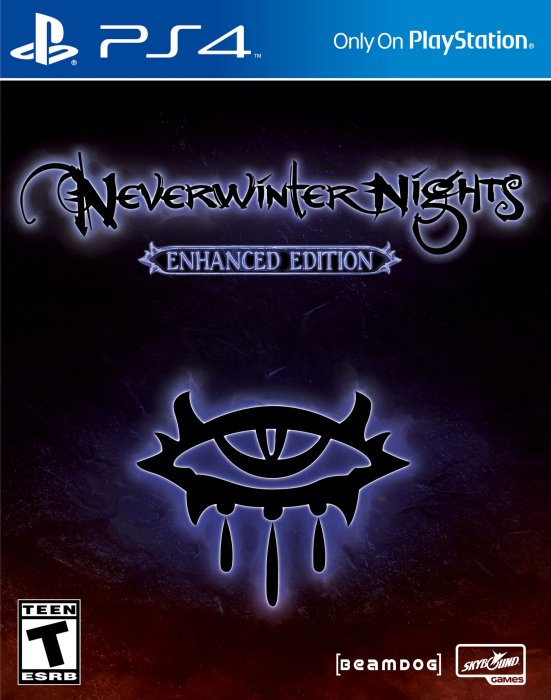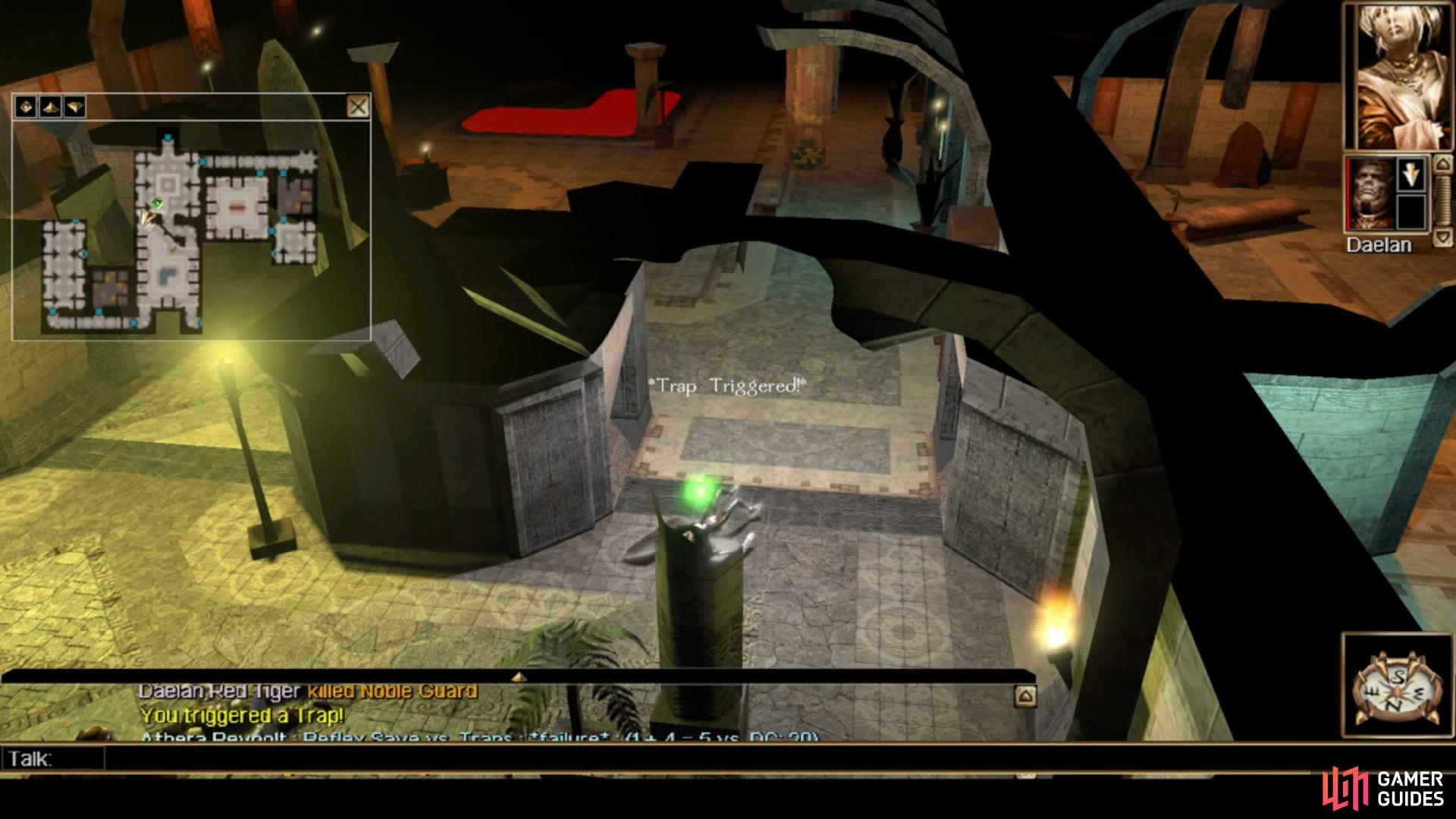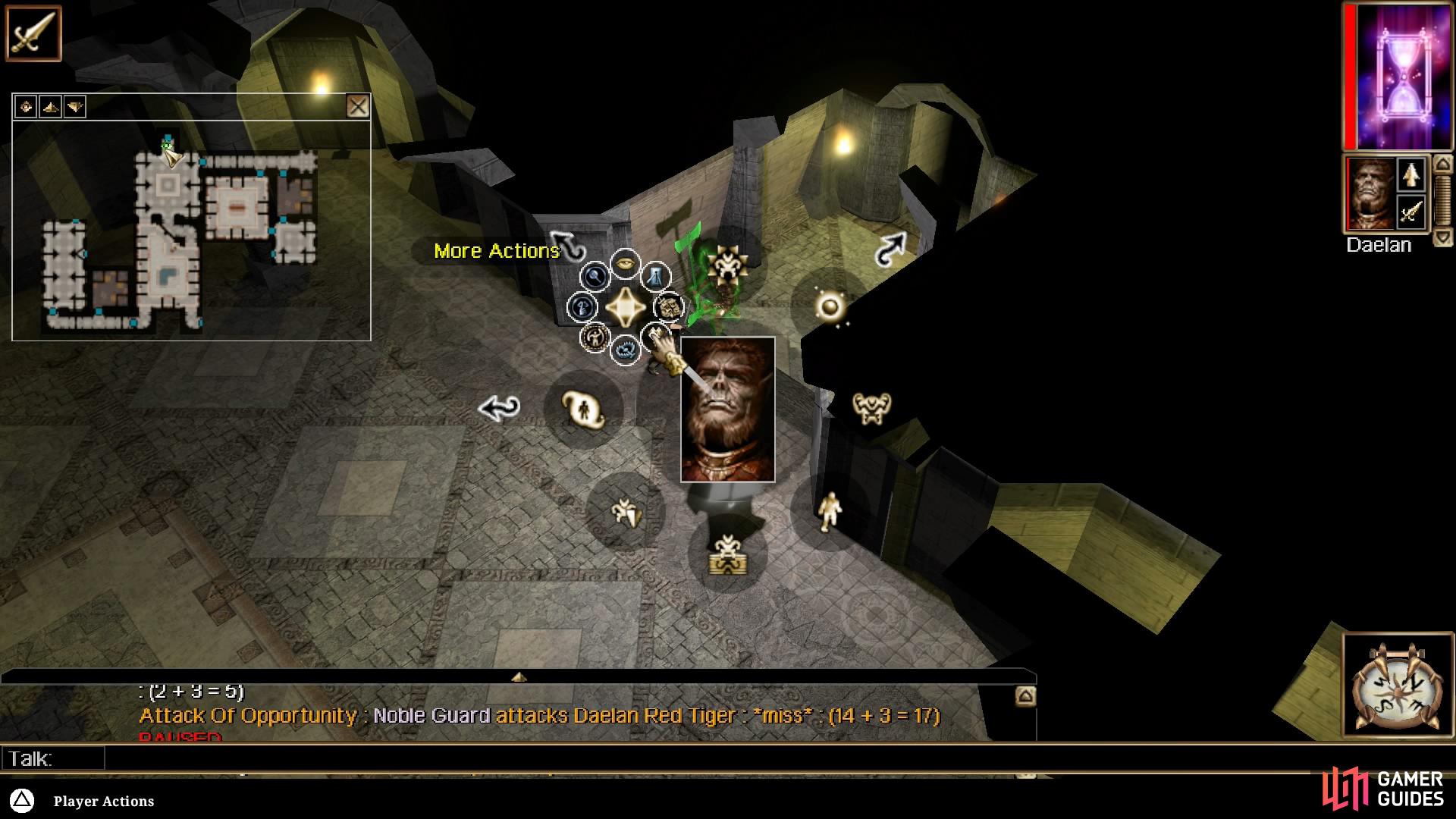
Neverwinter Nights: Enhanced Edition Review

Pros
- Multiple lengthy campaigns and optional modules.
- Deep character customization.
Cons
- Much more expensive and lacking content when compared to the PC version.
- Out-dated graphics and technical hiccups.
- Controls and menus not well-suited for controllers.
- Slow, unbalanced gameplay.
- Desolate multiplayer.
At the turn of the millennium, Bioware was a burgeoning force in the western role playing game market. Having made a great first impression with its earlier Infinity Engine games, they sought to cement their legacy as one of the industry’s best and move into the third dimension with Neverwinter Nights. While moving forward both technologically and conceptually - being one of the first games to use the 3rd Edition Dungeons and Dragons ruleset - they looked backwards for inspiration, finding it in the form of the original Neverwinter Nights (1991), which itself was one of the first online multiplayer role playing games, using graphics and mechanics similar to the Gold Box series of Dungeons and Dragons games (Pool of Radiance, Curse of the Azure Bonds, etc.) Given its impressive pedigree and the commercial successes of Enhanced Editions of the aforementioned Infinity Engine games, it was little surprise when Beamdog announced the development of Neverwinter Nights: Enhanced Edition, which joined its fellow games on console late in 2019.
The amount of content you’ll be getting with Neverwinter Nights: Enhanced Edition shouldn’t be in doubt, as it comes with a fairly lengthy four chapter campaign, two sizable modules (Shadows of Undrentide and Hordes of the Underdark), six “premium” modules and four “other” modules. There’s no doubt that there’s a whole lot of game here, even if the asking price of $50 is somewhat steep considering you can get the same game - arguably a superior version, as you’ll see - on PC for a mere $20, and often much cheaper during many frequent sales.
The game’s plot is serviceable enough, if uninspired - a plague of mysterious origin has afflicted the city of Neverwinter, and all other remedies failing, the city has set out a call for heroes to come help the city from this scourge. As the story progresses you’ll leave behind the city of Neverwinter, your search for a cure will turn into a search for an evil cult, and as is apparently required for any game set in the Forgotten Realms your adventure quickly turns into a mishmash of important locales, brushes with out-of-place but prominent lore and cameos that don’t make a whole lot of sense. Aside from the main narrative you’ll of course be able to undertake various side quests which, while tracked well enough in an in-game journal, very little indication is given about what characters will offer these quests nor how exactly you need to go about completing them. While there is the odd bit of witty banter here and there, the characters mostly fall flat, and what clever writing exists is often buried under paragraphs of utilitarian chatter that serves little besides offering crude flavor and a reminder of what you’re supposed to be doing.
The graphics weren’t good at the time, nor have they aged particularly well.
You are one such hero, and as is the norm for a Dungeons and Dragons game you’ll need to create your protagonist. Even for those familiar with the pen and paper ruleset, this is a tedious, complicated process that involves picking a race and class and - since Neverwinter Nights is based on the 3rd Edition ruleset - a variety of skills, feats and perhaps spells, varying depending on what race or class you chose. While the game does a relatively admirable job of explaining each of these choices, dedicating half the play screen during character creation to the task, those unfamiliar with the rules may wish to pick a premade character. This will at least ensure you end up with a serviceable 1st-level character whose attributes, feats and class aren’t complete non-starters.
Even experienced players may have trouble parsing the dozen or so starting classes and the pros and cons of building to any of the other dozen(ish) prestige classes, much less picking suitable skills, feats and spells along the way. Suffice to say, one of Neverwinter Nights’ biggest strengths and most dire liabilities is its deep character creation system. Spanning a whopping forty character levels possibly split up between three different classes per character, gaining skills, feats and spells on a regular basis, there’s equal room for customization and confusion. In this case, the core game’s antiquity ends up being a boon, as there are various guides and other online resources that can help you pick a build pioneered by a previously player years, if not decades ago.
Normally the idea that one could (perhaps even should) use external resources to help make a game easier to advance might be a mark against said game, but an online community has always been a key feature of Neverwinter Nights. It is some surprise, then, that a game that relied so heavily on player-created content was ported to consoles without such fundamental features. While online multiplayer exists in this version of the game, all the robust module creation and editing tools that made the game so popular on the PC are missing. As for multiplayer itself, it is unnecessary to actually play the game - the entire campaign can be completed single-player - but many more frustrating issues arise in the absence of a team of players to share your adventure with. As of this writing, a search for public online games yielded a total of six players split across four games (one was password protected), so unless you’re bringing a group of like-minded, reliable friends with you (all of which will need their own copy of the game), finding random players online isn’t something you should count on.
While multiplayer might mitigate some of the balance issues in the main campaign, the online scene isn’t particularly lively.
While the lack of module creation tools and a robust multiplayer base are issues apparently unique to the console version, another, long-standing problem exists and is exacerbated by the two previously mentioned short-comings - the campaign is fundamentally unbalanced. Since much of what makes a pen and paper Dungeons and Dragons session fun doesn’t translate well into a video game, Neverwinter Nights has to rely more on dice rolls rather than role playing. This isn’t a concern unique to Neverwinter Nights, of course, but many other Dungeons and Dragons games permit the creation of a party with diverse abilities suited to a variety of dangers, you had a reasonable way to bypass these. Not so with Neverwinter Nights, where you’re permitted only your protagonist, one pregenerated henchman you can hire and whatever your protagonist can summon (if anything) to deal with the throngs of enemies and traps that seem almost more numerous than cobblestones in the city of Neverwinter.
If your protagonist is some warrior class or another (Barbarian, Fighter, Paladin, Ranger, etc.) with high Hit Points, you might do better against groups of enemies. If you’re a rogue, combat is not your forte, but you can (hopefully) pick locked chests and traps, while if you’re a caster of some sort - say a Bard, Cleric, Druid, Sorcerer or Wizard - you probably don’t have much of a low-level answer for either. As mentioned you can hire a henchman, but only one, and none of them will be as competent as a player-generated character could be. If you hire a half-orc barbarian, you’ll have a useful companion for slug-fests, while a halfling rogue might get you through some traps, but you’ll still find that in the best case scenario you won’t have enough characters to deal with everything thrown at you. The usefulness of your companions is further reduced by terrible AI and pathfinding and - despite an over-abundance of radial menus - any means of reliably getting a companion to move to the right place, at the right time, and attack the right enemy. The number of times a companion stood just a few feet away without doing anything to help in a fight, or stood in a doorway blocking us from joining the fray were too numerous to count, and the wonky nature of combat is further exacerbated by Attacks of Opportunity that punish you for any missteps made during combat.
Traps are an obnoxiously ever-present scourge that serve little purpose but to waste your time, however you’re able to deal with them.
More on those radials in a moment, but to emphasize the core tedium of your average bout of gameplay in single-player Neverwinter Nights, we can merely summarize a bout of exploration from near the beginning of the game. After wandering at a snail’s pace (unencumbered, we assure you) through one of Neverwinter’s ghastly, dull gray districts we enter a house, the location of a side quest. Inside the comically large mansion (the interior of which is just as gray and brown as the city outside) we found several traps in the first room. If you’re capable of it you can find traps with a passive Search skill check. This might require several moments of standing around and waiting to detect the traps in the vicinity (if your character is even capable of it) after which you can - if you have a character with the Disable Traps skill - select the red shape that indicates the trap’s location and hopefully pass your skill check to disarm it.
If you can’t find or disarm the trap, you’ll probably just stumble over it and take an absurdly variable amount of damage, depending on the potency of the trap. The danger provided by these traps doesn’t seem to logically scale with the rest of the campaign, and a relatively low level character could step on one trap and take several points of damage while another trap deals over one hundred damage. Traps with this sort of lethality aren’t just found in different chapters of a single module, or different areas within a chapter, but within a single room of a dungeon. Of course even this is a gross over-simplification of matters, as each trap is recklessly variable from one another, but the efficacy of traps (not to mention spells and some monster abilities) you’ll encounter is further influenced by the three different Saving Throw checks they can challenge (Fortitude, Reflex and Will) which different classes and characters with different attributes will have higher or lower chances of passing and hence resisting some or all of a trap’s damage and any other nasty effects that accompany said trap, like attribute drain or paralysis. So, whether you’re waiting to find and disarm traps, waiting out or resting off the effects of said traps, or reloading after an unexpectedly lethal trap one-shots your character, each of the game’s overly abundant traps slows an already glacial, clunky game to a crawl, almost turning what should be a strategic role playing game into a less intellectually stimulating and somehow less graphically impressive version of Minesweeper.
If it feels we’re belaboring this point, keep in mind this was one room of about a dozen in one dungeon in the first chapter of the game. You’ll repeat this process many times over during the course of the game, and whatever you class or that of your companions is, the cycle of fighting, resting, dealing with traps, resting, dealing with more traps, resting, then slogging through an uninspired dungeon to the next room is not endearing. With a mixed group of characters playing online who can handle such dangers, the tedium decreases by degrees, but without that the amount of your time this game wastes inevitably inspires the mind to start pondering one’s mortality and why you’re not doing something - anything - else with your life.
Those problems alone would make this game hard to endorse for anybody doomed to play alone, but the console port adds an extra layer of frustration to nearly every aspect of the game by virtue of the apparent lack of effort that went into this port. In 2002 the graphics of Neverwinter Nights weren’t impressive, something the game made up for in scale and customization, but the console version of the Enhanced Edition lacks the customization and the scale is nothing impressive by modern standards, and leaving the frankly ugly graphics largely untouched did this game no favors. It’s even more disappointing that the game doesn’t even perform all that well, constantly stuttering and skipping, and while the combat isn’t exactly fast-paced, with so much RNG flying around at any given time, having the game skip a second or two and causing you to get hit by an Attack of Opportunity can cause a fight to turn against you, especially if you’re a caster who really needs to mind their position.
If you love multilayered radials, Neverwinter Nights delivers in spades.
Worst of all are the controls, and this may just be a game that shouldn’t have been ported to console at all given the inherent complexity of running a 3rd Edition Dungeons and Dragons system in real time. If it were going to be ported, however, perhaps some smart retooling of the menus could have saved it. As it stands, the game on console uses largely the same menus that the PC version did, and what worked for a mouse and keyboard does not, obviously, translate well to a keyboard. The prime-mover of the game are its numerous radial menus which are assigned to both trigger buttons, one covering universal options like emotes, special abilities, companion commands, spells and special attacks, while the other is more customizable - ideally where you’ll map regularly-used gear, consumables, spells, skills and abilities.
The sheer number of these menus some characters can have gets quite out of hand, however, as one radial menu can lead to another and another. For example, most spellcasters can select their spells by pressing one radial trigger, then selecting the “Cast Spell” icon which moves to another radial menu, where you’ll need to pick which class’s spell you want to choose from, which then leads to another radial menu for each level of spell you have, which in turn leads to yet another radial menu comprised of all the known spells of that level. You can pause the game via the touchpad to navigate this labyrinthine Matryoshka Doll of menus, but the process quickly wears out its welcome, and even though you can expedite this process by mapping regularly-used spells to the custom radial menus, any dedicated spell-casting class will likely end up with several wheels full of mapped spells, equipment, consumables and abilities in short order there, too.
Compare this to the PC version where you can just map a list of abilities to a bar at the bottom of the screen. A similar design was even implemented on the Enhanced Editions for, say, Baldur’s Gate, and while not as elegant as the PC version, it’s still far less cumbersome than the ported controls of Neverwinter Nights, and a missed opportunity. Instead, Neverwinter Nights: Enhanced Edition saves the bottom of the screen for a status bar that thankfully shows various gameplay information (which is hassle enough to scroll through if you want to find out what RNG afflicted you), which, characteristically for this port, is obscured by a virtually useless Talk bar. Why would anybody waste time typing - via the Playstation 4, mind you - into the Talk bar when they could just form a party and chat via a headset? Well, that’s how it was in the PC version, so obviously that’s how it’s going to be for the console version.
Perhaps the best way to summarize the controls for this game is to merely recount the steps necessary to save over an existing save slot. Options. Right. Cross. Down. Cross. Cross. Cross. Down. Cross. Nine button presses across four buttons. No quicksave. Autosaves are scarce. Sure, it might seem like a minor gripe, but when you’re playing dungeon Minesweeper and every hallway or chest can contain a trap that’ll instantly kill you, it’s a nuisance that becomes a significant flaw through compounding with other flaws and sheer repetition.
It’s really a shame that more wasn’t done to make the console version of Neverwinter Nights more friendly. While asking for better graphics might not be reasonable, any consideration towards making the game play more smoothly with a controller was a virtual necessity to pull this port off. The complexity of the game is both a strength and weakness, and while the game contains enough gear, skills, feats, spells to create a wide variety of builds - and diverse creatures to slay with these builds - to appease anybody, putting up with the game’s control and performance shortcomings and design flaws makes the console version difficult to recommend to anybody. Especially if you don’t have a good group of friends willing to share your adventure with.
Poor port of a great CRPG.
While overflowing with content, the console port of Neverwinter Nights: Enhanced Edition suffers from technical issues and poor controls. If you have a group of dedicated friends to adventure with the experience may be worthwhile, but there’s little compelling reason to prefer this version over the cheaper, more feature-rich PC version.
Sound:
Value Rating:





No Comments